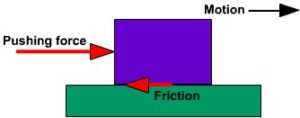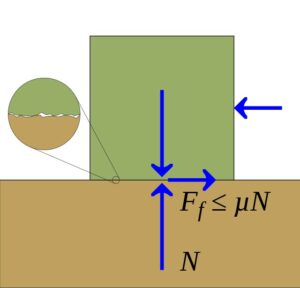It is hard to move from one place to another without friction. But what is friction force? Is Friction A Conservative Force or non-conservative? Here we are going to discuss these questions.
When two objects slide or rub on each other, friction occurs between them. This friction tries to stop the relative motion of these two bodies by applying some force on each body. This force is called friction force. As the friction force depends on the path, so it is not a conservative force.
Friction: A necessary evil
When two bodies move relative to each other and slide or rub on each other, friction occurs. Friction force always acts opposite to the direction of the motion. Friction is a necessary evil for motion, it is a self-adjustable force and depends upon the surfaces of bodies that are come in contact, or we can say it depends upon the path in which the relative motion occurs.
We can walk just because of friction, a bus can move from one place to another only because of friction, a bullet fired from a gun slows down due to friction, etc. So what is friction? What is friction force? Is it a conservative or non-conservative? Let us discuss these questions in detail.
Friction is mainly of two types,
- Static friction
- Kinetic friction
Static friction– The opposing force comes into play when a body tries to move over the surface of another body, but the actual motion that has yet not started is called static friction. E.g., a book on a shelf, a car in a parking lot, a metal cube on a table surface, etc.
The equation for the force of static friction is,

Where,
N – a normal reaction

Image credit:Maxmath12, CC0, via Wikimedia Commons
Kinetic friction– Kinetic friction is friction between two bodies in moving conditions. Kinetic friction is always the opposite of the motion and tries to stop the motion, such as friction between the road and a moving car, friction between sliding wooden cube on an inclined plane surface, etc.
The equation for the kinetic friction

Where –
μk-coefficient of kinetic friction
N -normal force

Image credit: Polyvore, Public domain, via Wikimedia Commons
Nature of friction force
Forces are of two types’ conservative forces and non-conservative forces.
Conservative force –
The force that depends on the initial and final displacement of the object and does not depend upon the path of motion is called conservative force, for example, gravitational force, electrostatic force, etc. In conservative force, work done is independent of path. Total energy under conservative force remains constant.
Non-conservative force –
The total energy does not remain constant under the influence of non-conservative force forces. In the non-conservative forces, work done is depends upon the path by which motion occurs. The friction force, tension, and force over a wooden block are examples of non-conservative forces.
So from the above discussion, we can say that the friction force is non-conservative because it depends on the path. To understand it more accurately, consider a metal cube on an inclined plane,
Firstly we place that metal cube on a smooth surface inclined plane. In this case, the cube quickly moves on a surface because the friction between the cube and the inclined plane is very weak. Therefore cub can easily slide down on a smooth surface.
Now place the same cube over a rough surface inclined plane of the same inclination as a smooth plane. In this plane, the cube needs to do more work to slide over an inclined plane. Here, the friction between the cube’s surface and the inclined plane is greater than the smooth surface. Hence friction depends upon the path of motion, and that’s why it is a non-conservative quantity.
FAQ’s
What is normal force?
We can stand on the ground because of this force.
The ground exerts a force of reaction on the object equal to its weight is called the normal force. This force is always perpendicular to the surface.
What is limiting friction?
The definition of limiting friction is as follows.
When the applied force exceeds the static friction force, the body starts to move. So limiting friction is the maximum value of static friction up to which the body remains in the state of equilibrium.



What is the angle of friction?
The angle between the normal reaction and the resultant limiting friction is called the angle of friction.



Also Read:
- What is wet coefficient of friction
- Relative motion in friction
- Wet friction
- Friction welding
- Reduce friction
- How to find acceleration with coefficient of friction
- How to find normal force with coefficient of friction
- How to find constant velocity with friction
- How to find acceleration with friction
- Bad friction
I am Shambhu Patil, a physics enthusiast. I have done M.Sc. in Physics. Physics always intrigues me and makes me think about, how this universe works. I have an interest in nuclear physics, quantum mechanics, and thermodynamics. I am very good at problem-solving and explaining complex physical phenomena in simple language. My articles will walk you through each and every concept in detail.